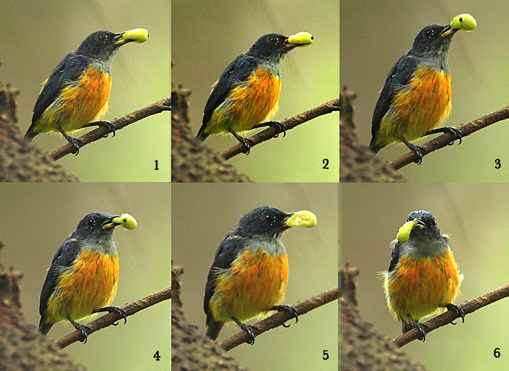Yes, how does an Orange-bellied Flowerpecker (Dicaeum trigonestigma) tackles the fruits of the Indian cherry tree (Muntingia calabura)?
In an earlier post, KC Tsang gave an account of how this flowerpecker ate the fruits of the Indian cherry tree. The adult male pierced the partially ripe fruit with his lower mandible and with the help of the upper, compressed the fruit to get at the sweet pulp. A recent observation, complete with photographic evidence by Chan Yoke Meng, documents another method of feeding on the same fruit.
This was once a very common tree around the urban environment, spread far and wide by birds. Because birds flock to the fruiting tree, they leave a mess below that needs to be cleaned in a Singapore where labour was then becoming expensive. The tree is now not that common, found mostly in rural areas. The fruit is a small round berry of about 12 mm diameter, with numerous tiny seeds embedded in a soft, sweet pulp.
The sequence of the bird handling the fruit is shown above. It first picked the fruit by pulling it from the stalk. Then on a nearby perch it started to squeeze it with the stalk end towards the mouth. Because of the tear at that end of the fruit, the content was easily squeezed into the bird‘s mouth.
It then turned the fruit around and squeezed it on one side, then on the other. It finally positioned the fruit so that the stalk end was directed towards its mouth. After swallowing what was left of the content, it discarded the empty fruit skin.
The entire process lasted about slightly more than a second.
Chan Yoke Meng
Singapore
September 2007










2 Responses